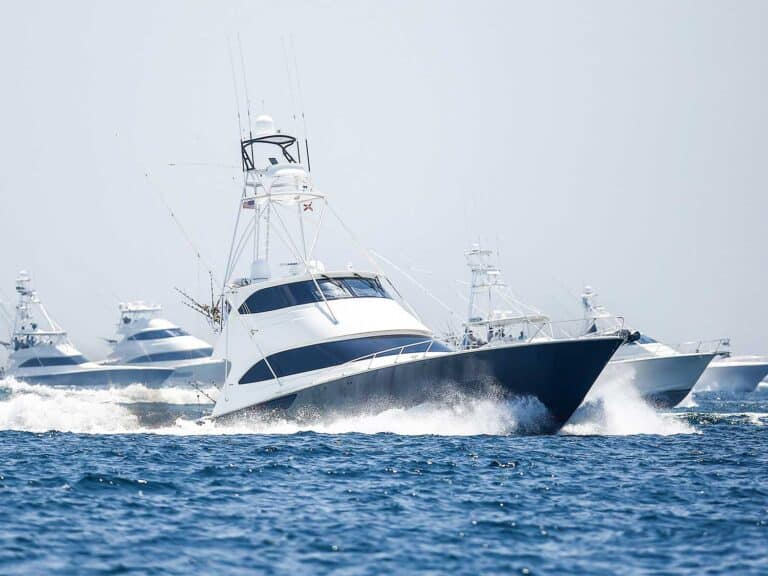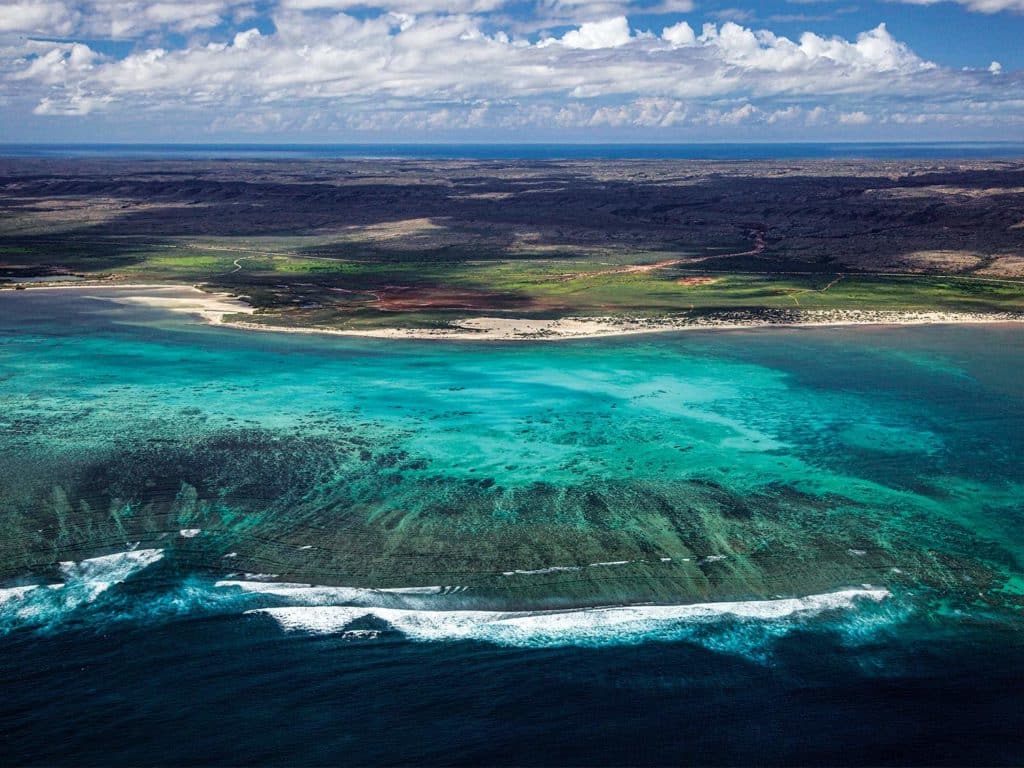
For those of us who are obsessed with the pursuit of billfish, our thoughts often wander to the next far-flung destination that has yet to be discovered. In our imaginations, it is a tropical island miles from the nearest landmass, with a name we can hardly pronounce or in a country we’ve never heard of. But sometimes, these places are in familiar territory—they’re just not where we’re used to looking.
When marlin fishermen think of Australia, the famous giant black marlin fishery of Cairns and the Great Barrier Reef is usually the first thing that comes to mind, and for good reason. But in the past decade, another fishery has emerged on the opposite coast of the land Down Under. Enter Exmouth.
This coastal town of about 2,500 year-round residents is located on the point of the North West Cape in Western Australia, about 790 miles north of the state capital of Perth, and 2,092 miles southwest of Darwin. The majority of WA is spread out and sparsely populated, which is why this region is considered the wild side of Australia. What makes Exmouth special is similar to what has made Cairns hallowed ground in the world of big-game fishing: the proximity of a major reef system and those oh-so-favorable ocean currents.
The Ningaloo Reef might not get the press of the Great Barrier Reef, but it is the world’s largest fringing reef. And although the GBR is quite a bit larger at over 1,400 miles long, it is considered a barrier reef. The Ningaloo stretches out over 186 miles from Bundegi Beach in the north to Red Bluff at Quobba Station to the south. It was classified as a UNESCO World Heritage site in 2011 because it’s one of the most biologically diverse marine environments on the planet, with over 250 species of coral and over 500 species of fish. The warm water of the Leeuwin Current pushes up bait—on and off the edge of the reef—and creates a unique situation that draws in all of the billfish species that can be found in the Indian Ocean to this area. Blue, black and striped marlin can all be caught here, along with sailfish and an emerging fishery for swordfish. And while the prime seasons vary a bit between the species, there’s almost always the chance for a slam of some kind. And Exmouth isn’t just a fishery based on numbers and diversity—there are proper giants here too.
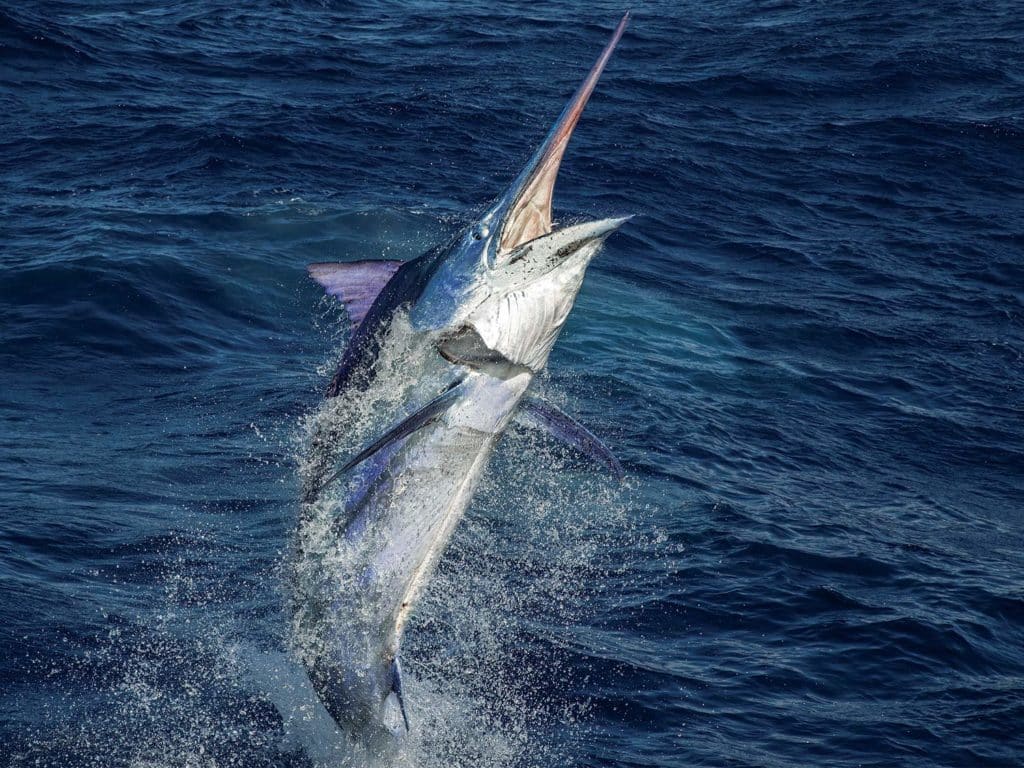
Big-Fish Exmouth
On New Year’s Day 2018, Capt. Eddy Lawler and his Peak Sportfishing crew burned Exmouth’s legacy into sport-fishing history by catching a 1,089-pound blue marlin. This was not only Australia’s new all-tackle-record blue, but it was also the first-ever grander blue weighed in a country with an extremely rich and proud history of marlin fishing. The giant was raised on a Bonze Violator lure—one of Lawler’s favorites—and then switched over to a skipjack tuna rigged with a circle hook. After a three-hour battle on 130-pound stand-up gear, Australia’s most famous blue marlin was boatside and headed to the scales.
Like anywhere else in the world, the giant blues of Exmouth aren’t a frequent occurrence, but you might have a good or better chance here as any of the other big-fish destinations that get a lot more recognition. Wes Jones, crewman for Lawler, says they usually get a shot or two at a grander-plus-size blue marlin each year. And with only four or five regular charter boats, as well as a handful of local recreational trailered boats working this area for billfish, that makes your odds much better than the lotterylike conditions found in many of the world’s other big-fish locales.
In his 11 years as an Exmouth charter captain, Lawler says that his average blue marlin is between 350 and 400 pounds, and that historically, 1 in 10 fish is 500 pounds or better. This statistic is enough to raise eyebrows in itself, but Lawler also says that during the prime blue marlin season, from October to February, they average about two shots per day on blues, with the potential for many more. For a fishery that boasts of fish in this size class, that is about as consistent as you can get anywhere.
Large black marlin can also be found in the same areas and same time of year as the blues. The average black is closer to 200 pounds, with many much smaller, but Lawler insists he and his crew still see a few over 500 pounds each year, with some over 800, so it’s probably only a matter of time until a 1,000-pound black is pulled from the waters around Exmouth as well.
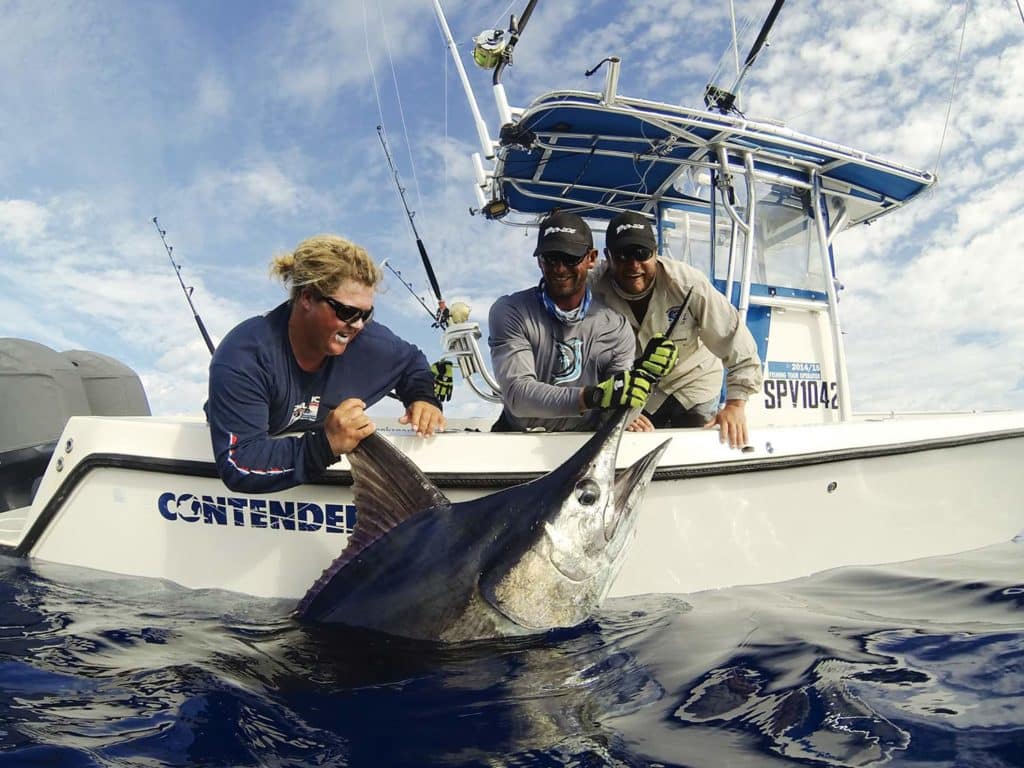
Aussie Technique
As far as fishing style, most of the captains around Exmouth with whom I spoke are trolling a combination of lures, teasers and dead baits. The most common method seems to be bait-and-switch fishing: pulling hookless lures and then switching the fish over to a circle-hook-rigged dead bait once it’s raised. This method is a little more full-contact than a typical trolling pattern with hook baits and lures, which allows the angler to be more involved in the hookup process. This also allows the crew to pick the best outfit for the size and species of fish that find their way into the spread.
Gear from 30- to 130-pound class is most common among the fleet for their everyday charters, but this teasing technique also lends itself perfectly to those who want to chase world records on light tackle or fly. Or, for another option, the sailfish in the Exmouth Gulf can be caught by casting liveys to the fish that are balling bait during the peak season, from September through November.
While big fish might grab the headlines, the word that continually came up when I asked these experienced captains about what sets Exmouth apart from other destinations was diversity.
Exmouth Has It All
Josh Bruynzeel grew up in Western Australia and has been a charter captain based out of Exmouth for 10 years. He got excited when I asked him about what he thought made Exmouth such a unique place to fish. “Big blue marlin, a year-round black marlin and sailfish fishery, aggregating sails in the Gulf for a quarter of the year, swordfish close by offshore, and striped marlin off the back of our canyons. Yes, that is blue, black, sails, stripes and swords—all right here,” he says. With these species in such close proximity, and overlapping fishing seasons, the possibility of some unique grand slams—and even an opportunity for a super slam—is a realistic goal.
Blue marlin have been caught all year long, but the prime season is from October through March. Blacks and sails are caught in consistent numbers throughout the year, with the best month for blacks being March through August, and the spike of the sailfish season occurring in October through December. If you’re bringing the family to Exmouth, or want to take a day off from chasing billfish, Bruynzeel says they’ve got that covered too. “Our coral flats hold trophy-size bonefish and permit, and the fringe reef holds big giant trevally, red bass and king mackerel. Offshore, there are big yellowfin tuna in the summer months. I’ve always said if we could catch dogtooth tuna, tarpon and roosterfish here, you would never have to fish anywhere else!”
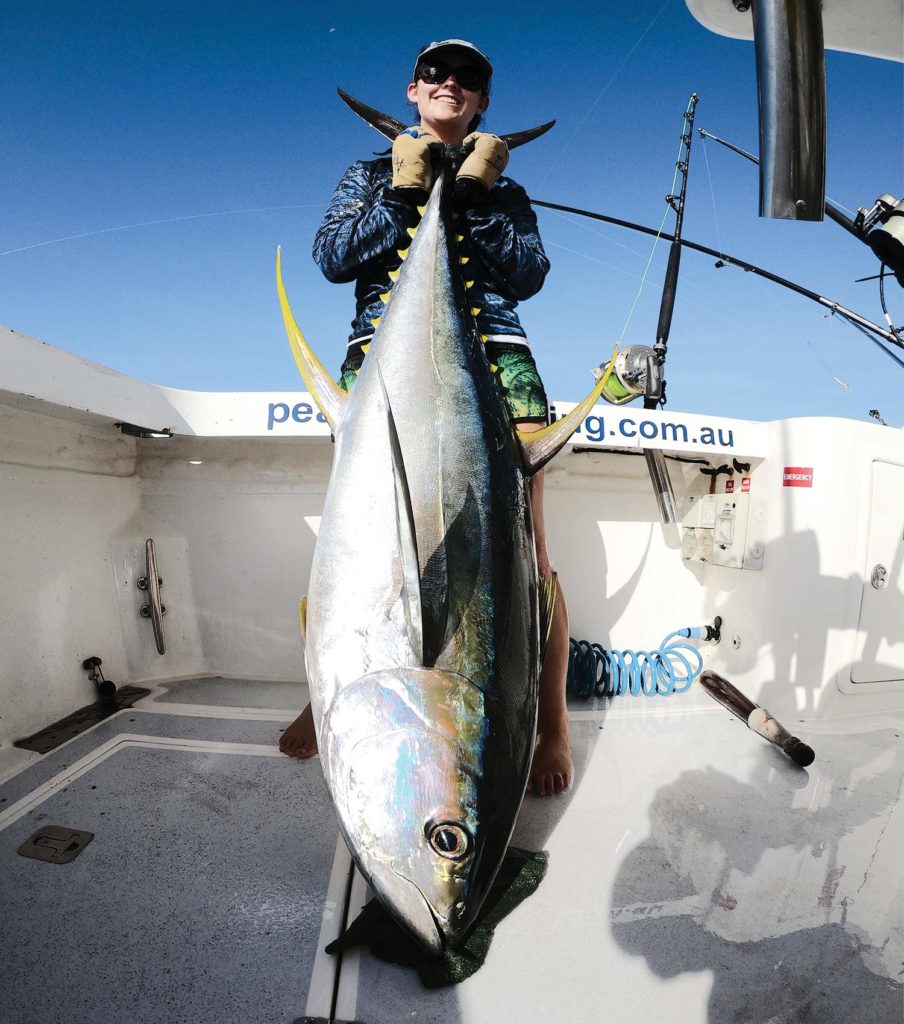
Location, Location, Location
Short runs to the marlin grounds is another element that makes Exmouth such an appealing billfish destination; the average run can be as short as 3 miles to the edge of the reef. Lawler says that 12 miles is about as far as they’ll run before they start fishing when they’re targeting blue marlin. This is especially important when considering that the sea conditions can be a bit rough there at times. While you might still get some bluebird days, Jones says that the average wind speed is around 15 to 18 knots, with some 25-plus-knot days thrown in. Like a lot of fisheries around the world that are located close to an extensive reef system, these winds can be a positive factor in the Exmouth fishing equation—whenever the deep offshore waters are pushed up against the reef, scores of baitfish and hungry predators eagerly follow.
In a remote part of Australia, reaching Exmouth takes a bit more effort. This isolation creates an advantageous situation in the competition for bites. Each of the local captains I spoke with said that it was not uncommon to fish all day without seeing another boat in the vicinity, and even on a busy day, they rarely saw more than seven or eight boats fishing any single area at the same time. Bruynzeel says that the few charter boats that ply the waters off Exmouth each day stay in communication with one another, keeping the flow of information open, which keeps the fleet in the most productive areas. With such a large range of ground to cover and so few boats covering it consistently, this information is invaluable to stay on the bite at any given time.
Additionally, the lack of serious commercial-fishing pressure around the Ningaloo Reef adds to the health of the fishery because longlines are not permitted within 200 nautical miles of this area.
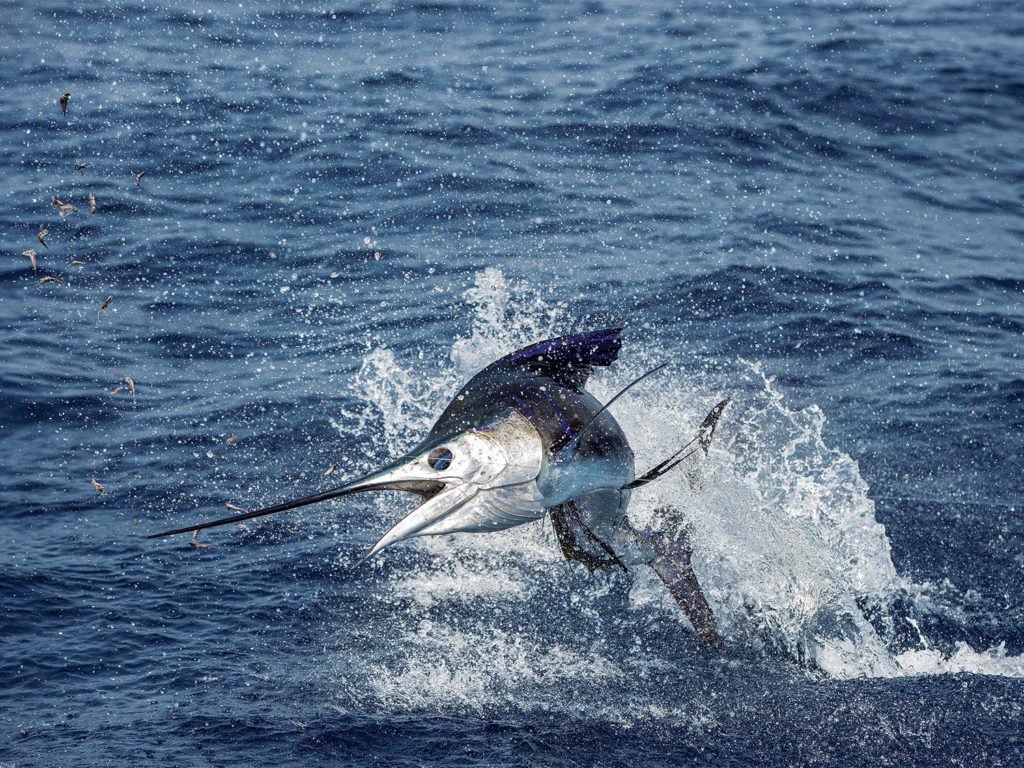
Light-Tackle Dreams
Dean Butler has fished almost 150 days in the waters around Exmouth since 2008, both as crew and as an outfitter guiding his clients in search of world records on light and fly tackle. After spending time in virtually every billfish hotspot around the world, Butler ranks Exmouth as one of his favorite destinations on the planet. “The fishing is great, and even when it’s slow, it’s still better than most places,” he says. “It doesn’t really compare to anywhere else I have fished, and I don’t know where else you can catch a Pacific blue, black and striped marlin, and sailfish, as well as get a shot at a swordfish all in the same day.”
In 2010, he arranged a 25-day fly-fishing charter that yielded four Australian records—three blacks and one sail—and caught a total of 28 billfish all on 16- and 20-pound fly tippet. The charter also pulled the hooks on two blacks over 250 pounds, which would have broken the 20-pound tippet record had they been landed. On that same trip, they had a single day that raised 13 fish—three sails, three blacks, three stripeys and four blues—with one of those reaching the 800-pound class.
Those numbers aren’t just a fluke. Virtually every captain who has spent a significant amount of time in Exmouth reports having multiple double-digit billfish days. The size of the black marlin off the edge of the Ningaloo Reef, along with their aggressiveness and willingness to make the switch from the teaser to a bait, makes it a prime location for anglers who are seeking world records on fly and light tackle, or those who are just interested the challenge light gear provides.
In a sport that so oftentimes rings back to the old saying “you should have been here yesterday”—whether relating to a fishery as a whole or declining fish populations—or more directly, just missing the bite by a day, Exmouth defies that axiom.
The captains told me that their numbers were actually improving each year, encouraging the idea of stable fish stocks in this region and the notion that as a relatively new fishery, local captains are learning the patterns of the area and adjusting accordingly. And with a lack of commercial pressure and ease of access for recreational vessels, this just might prove to be the case for years to come.
The bite consistency and variety of species found here also make a case for Exmouth to be an extremely reliable fishing destination that allows you to maximize your opportunity for success while you’re there. So, while it might not be the easiest place to reach logistically, those who make the effort are often rewarded.
Exmouth offers the allure of a relatively untapped fishery, low fishing pressure, multiple species and good possibilities of big fish, all the while being less than 15 miles from shore—and back to civilization and a warm bed at night. If you’re up for a unique billfishing adventure, it might be time to include Australia’s wild side and check out Western Australia’s North West Cape. I’m glad I did.
Air Travel
Getting to Exmouth usually requires a layover (or two), whether you’re traveling from the United States or within Australia. Many US carriers offer flights to Australia’s major airports such as Sydney, Melbourne or Brisbane, and from there you connect to Perth, then take one of the two daily nonstop flights to Learmonth Airport—the closest airport to Exmouth, around 25 miles away—offered by Qantas. The same applies if you’d like to fit in a trip while visiting Cairns, with Jetstar Airways also connecting in Perth. This was prior to the ongoing pandemic though, so be sure to check with the airlines first.
Exmouth Bus Charter provides a shuttle service from the airport to your chosen accommodations for a per-person fee. Taxi and charter-vehicle services are also available between the Learmonth Airport and Exmouth.
Fishing
- Capt. Eddy Lawler, Peak Sportfishing
- Dean Butler, Dean Butler’s Sportfishing Adventures
- Capt. Josh Bruynzeel, On Strike Charters
- Capt. Brendon Hawker, Innkeeper Sport Fishing Charters




